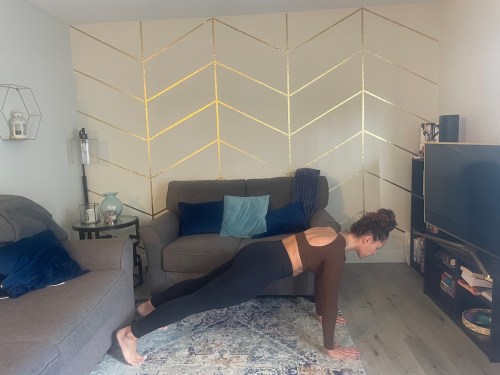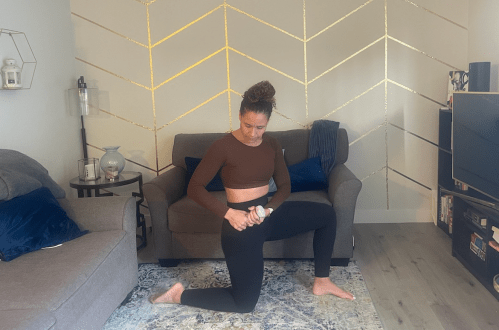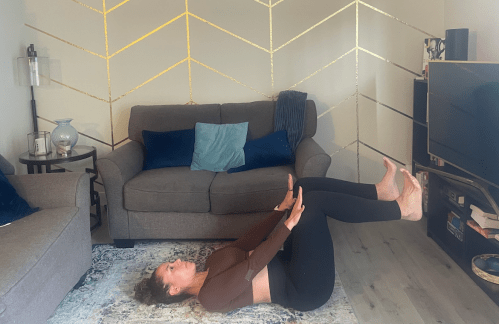The 7 Best Core Stability Exercises for Beginners To Add to Your Routine ASAP
Start your fitness journey with core stability exercises for beginners. Build strength and improve posture with these effective moves.

What are the first exercises you think about when you hear the words core training? Crunches and sit-ups probably come to mind. While you can certainly do those exercises to train your core, there’s much more to it than that.
Experts in This Article
certified personal trainer and founder of Core Studios in Providence, Rhode Island
It’s important to explore all of the ways in which you can build your core, as it is a fundamental part of your body. It plays a large role in your overall wellness and longevity, and should be a focus of your fitness routine.
Ahead, we dive into the best core stability exercises for beginners, plus the benefits of having a strong core and tips to get started.
For starters, what is your core?
Your core begins at your shoulder girdle, goes down to your pelvic girdle, and circles all the way around your body.
“Your core is made up of the center of your body. It’s the pelvis, lower back, stomach, and hips”, says Denise Chakoian, CPT, founder of the aptly named CORE.
More specifically, your core muscles include the following, according to the American Council on Exercise (ACE):
- Rectus abdominis: The top layer of your abdomen (sometimes referred to as the six-pack muscle) that flexes your trunk.
- External obliques: The outer muscles on the sides of your torso that rotate your trunk.
- Internal obliques: The muscles underneath your external obliques that rotate your trunk.
- Transverse abdominis: One of the innermost muscles of of your abdomen that holds your internal organs in place.
- Erector spinae: A group of back muscles that extend your trunk.
- Multifidus: The innermost layer of muscle in your back that stabilizes your spine.
Why do you need a strong, stable core?
Your core is the foundation of your body, and any movement from either your upper or lower body originates from there.
Think of your core like the foundation of a house: The foundation is the load bearing portion of that house. If the foundation is weak, the house would, at the very least, be wobbly and, at its worst, topple to the ground. To keep your body from falling over, you need to work on your foundation (or core).
“One of the reasons for a strong core is for balance training as we age. Using our core—and core stabilizers—helps us maintain good posture, which in turn helps with stability,” Chakoian says.
Your balance and stability is something that diminishes as you age, so working on your core strength at all ages is important to help with injury and fall prevention later in life.
Tips for beginners to start a core exercise routine
The great thing about core workouts is that you can do them using your own body weight, which makes them possible to do anywhere.
When beginning any new fitness routine, first get the green light from your doctor. Next, it’s important to remember not to overdo it. Start slow and gradually build up to higher repetitions or more resistance (like weights) as you get stronger. Ramping up a new workout routine too quickly could lead to injury.
The best core stability exercises for beginners
1. Plank

- 1.Lie face down on a mat with your palms on the floor underneath your shoulders and your feet flexed with the bottoms of your toes on the floor.
- 2.Press through your palms to lift yourself up into the top of a push-up position. Your body should make a straight line from your heels through your hips to the top of your head.
- 3.Draw your shoulders down away from your ears and brace your core.
- 4.Look at the floor directly below your head to keep your neck in a neutral position.
- 5.Start with holding for 30 seconds and gradually make your way up to 1 minute as you progress.
Tip: To make a plank easier, you can drop down to your knees. When doing a knee plank, still make sure your body is in alignment from head to hip. You can also perform a plank on your elbows if you have any wrist pain.
2. Bird dog
“This exercise really teaches your hips and core to turn on in the proper alignment,” Chakoian says.

- 1.Start on all fours in a tabletop position. Your wrists should be directly under your shoulders and your knees should be directly under your hips.
- 2.Squeeze your abs and simultaneously lift and reach your left arm in front of you and your right leg behind you.
- 3.Raise your left arm and right leg until they’re parallel to the floor.
- 4.Return to the starting position.
- 5.Squeeze your abs and simultaneously lift and reach your right arm in front of you, and your left leg behind you.
- 6.Continue alternating until all reps are complete.
- 7.Do 3 sets of 10 reps.
3. Half-kneeling wood chop
“Rotational work, like chops, is a great way to use your core in a transverse—aka horizontal—plane,” Chakoian says. “A chop consists of moving your body from one direction to another opposing direction to create that transverse effect.”

- 1.Start in a half-kneeling position with your right knee on the ground and your left leg in front, left foot flat on the floor. Both knees should be at 90-degree angles.
- 2.Hold a light dumbbell up by your left shoulder with both hands.
- 3.Rotate your core to the right and bring the dumbbell down to your right hip.
- 4.Return to the starting position.
- 5.Repeat on the other side
- 6.Do 3 sets of 6 reps on each side.
4. Inchworm

- 1.Start standing with your feet hip-width apart.
- 2.Hinge at your hips and reach your hands to the ground.
- 3.Walk your hands out to a high plank position.
- 4.Walk your hands back to meet your feet and return to standing.
- 5.Do 3 sets of 5 reps.
5. Dead bug

- 1.Lie flat on your back with both arms reaching straight toward the ceiling.
- 2.Lift your legs up to a tabletop position with your knees bent at a 90-degree angle and stacked over your hips.
- 3.Slowly lower your left leg and your right arm toward the floor at the same time, moving your arm from the armpit and your leg from the hip.
- 4.Return to the starting position and repeat with your right leg and left arm.
- 5.Continue alternating for 3 sets of 10 reps.
Tip: Keep a neutral spine and only go as far as your range of motion allows.
6. Knee press

- 1.Lie flat on your back with both arms reaching straight toward the ceiling.
- 2.Lift your legs up to a tabletop position with your knees bent at a 90-degree angle and stacked over your hips.
- 3.Bring your arms down to your knees and press your hands into your knees and your knees into your hands as hard as you can. Brace your core the entire time.
- 4.Hold for 15 seconds.
- 5.Do 3 sets of 3 reps, holding each rep for 15 seconds.
Tip: Make sure you’re breathing during this exercise. It’s easy to hold your breath when you’re bracing your core. Your core will shake if you do the exercise properly.
7. Superhero

- 1.Lie face down on your stomach with your legs extended and arms stretched above your head.
- 2.Lift your arms and legs off of the ground simultaneously, pausing for 2 seconds at the top.
- 3.Return to the starting position.
- 4.Do 3 sets of 10 reps.
FAQ
1. What are the signs of a weak core?
Signs of a weak core include bad posture, lower back pain, and difficulty balancing.
2. Is it okay to work your core every day?
Truly, any exercise you do will work your core if you’re bracing while you do it, so you’re constantly training your core. However, doing core-specific moves every day (like those above) should be done less often. Chakoian says,
“Training the core at least three times per week is a great way to not only feel better but also to gain results at the same time,” she says.
3. How can I train my core at home?
The great news about training your core is that you don’t need much space or equipment to do it, so core exercises are perfect for doing at home. You can use a program like the one above or use videos like this one on our YouTube for some variety.
Sign Up for Our Daily Newsletter
Get all the latest in wellness, trends, food, fitness, beauty, and more delivered right to your inbox.
Got it, you've been added to our email list.










